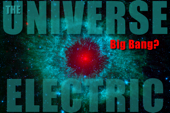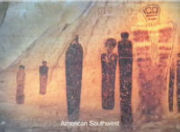Evidence Confirms Electric Comet Model
03/01/08
It appears that predictions made by Wal Thornhill and the Electric Comet model are being quickly confirmed, whether mainstream astronomers like it or not. In the end, it seems nature will be the arbiter of which model is the most accurate and predictive.
The Electric Comet [1.8Mb PDF] is a poster presentation from the Electrical and Electronics Engineers 33rd International Conference on Plasma Sciences (ICOPS), presented in early June 2006.
However, predictions go back considerably further, to include They Sing the Comet Electric, published by Wired News in 2005; Deep Impact Predictions earlier in 2005; Comets Impact Cosmology, published by Thornhill in 2004; and an even earlier reference from Thornhill, Comet Borrelly rocks core scientific beliefs dates to 2001.
In fact, predictions of electrical interactions at comets date back to comments from Harold Spencer Jones in his textbook General Astronomy (pp. 273-274) and such visionary works as Kristian Birkeland’s theory of comets way back in 1913, among others’.
In the initial news releases upon receipt of the Stardust mission’s payload, scientists intimated that the materials received from Stardust appeared to contradict the “dirty snowball” model of comets insofar as the materials retrieved appeared to have been “born in fire” rather than in the cold outer reaches (or the imagined Oort Cloud). The materials returned appeared to be crystalline in nature and in configurations that are only produced in regions of intense heat and high pressure.
News releases over recent weeks have now gone on to intimate that not only do the materials collected appear to have been born in fire, but “the Stardust material resembles chondritic meteorites from the asteroid belt” more so than the expectations of a “dirty snowball” or “snowy dirtball” model of comets.
Returning to the Electric Comet poster presentation, Wal Thornhill et al laid out the differences in approach, assumptions and expectations of the standard model of “dirty snowballs” and of the “Electric Comet” model.
DIRTY SNOWBALL MODEL:
-
Comets are composed of undifferentiated “protoplanetary debris” -- dust and ices left over from the formation of the solar system billions of years ago.
-
Radiant heat from the Sun sublimates the ices. The vapor expands around the nucleus to form the coma and is swept back by the solar wind to form the tail.
-
Over repeated passages around the Sun, solar heat vaporizes surface ice and leaves a “rind” of dust.
-
Where heat penetrates the surface of a blackened, shallow crust, pockets of gas form. Where the pressure breaks through the surface, energetic jets form.
ELECTRIC COMET MODEL:
-
Comets are debris produced during violent electrical interactions of planets and moons in an earlier phase of solar system history. Comets are similar to asteroids, and their composition varies. Most comets should be homogeneous -- their interiors will have the same composition as their surfaces. They are simply “asteroids on eccentric orbits.”
-
Comets follow their elongated paths within a weak electrical field centered on the Sun. In approaching the Sun, a charge imbalance develops between the nucleus and the higher voltage and charge density near the Sun. Growing electrical stresses initiate discharges and the formation of a glowing plasma sheath, appearing as the coma and tail.
-
The observed jets of comets are electric arc discharges to the nucleus, producing “electrical discharge machining” (EDM) of the surface. The excavated material is accelerated into space along the jets’ observed filamentary arcs.
-
Intermittent and wandering arcs erode the surface and burn it black, leaving the distinctive scarring patterns of electric discharges.
-
The jets' explode from cometary nuclei at supersonic speeds and retain their coherent structure for hundreds of thousands of miles. The collimation of such jets is a well-documented attribute of plasma discharge.
-
The tails of comets reveal well-defined filaments extending up to tens of millions of miles without dissipating in the vacuum of space. This “violation” of neutral gas behavior in a vacuum is to be expected of a plasma discharge within the ambient electric field of the Sun.
-
It is the electric force that holds the spherical cometary coma in place as the comet races around the Sun. The diameter of the visible coma will often reach millions of miles. And the visible coma is surrounded by an even larger and more “improbable” spherical envelope of fluorescing hydrogen visible in ultraviolet light.
-
The primary distinction between comet and asteroid surfaces is that electrical arcing and “electrostatic cleaning” of the comet nucleus will leave little or no dust or debris on the surface during the active phase, even if a shallow layer of dust may be attracted back to the nucleus electrostatically as the comet becomes dormant in its retreat to more remote regions.
In contrast to the “dirty snowball” model touted by many astronomers and/or astrophysicists as the pinnacle of their predictive ability, Thornhill et al have predicted that comets should in fact turn out to be consistent with the composition of asteroids, insofar as they are rocky bodies traveling in the sun’s plasmasphere.
It is this assertion that comets and asteroids have common genesis and will display common features and composition that is yet another experimentum crucis for the Electric Comet model. An experimentum crucis is defined by Wikipedia as:
[…] an experiment capable of decisively determining whether or not a particular hypothesis or theory is correct. In particular, such an experiment must typically be able to produce a predictable result that no established hypothesis or theory is capable of producing.
The production of such an experiment is considered necessary for a particular hypothesis or theory to be considered an established part of the body of scientific knowledge. It is not unusual in the history of science for theories to be developed fully before producing a critical experiment. A given theory which is in accordance with known experiment but which has not yet produced a critical experiment is typically considered worthy of exploration in order to discover such an experimental test.
Under the definition of a critical experiment (experimentum crucis), a prediction must be distinct from the predictions of other theories such that a clear test can be performed in order to distinguish which prediction is correct, and which prediction is incorrect.
To put it simply, the standard model expected comets to be the cold remnants of an “accretion disk,” or water and/or volatiles cemented together in or beyond the cold outer reaches of the solar system (in later revisions, the water and volatiles, not having been observed on the surface, were posited to exist below the surface, invisible and hidden out of the reach of our observational power).
The Electric Comet model, on the other hand, expects comets to display relatively homogeneous composition similar to that of meteorites. In fact, the Electric Comet model appears to say that they have common origin in catastrophic electrical discharges that literally electrically machined the surfaces of planets in our solar system in a relatively recent geological epoch, leaving identifiable electrical scars on those parent bodies and often on the comet / asteroid surfaces as well.
Data and samples retrieved from cometary bodies have not borne out the standard model scientists’ claim unambiguously. They have claimed that OH radicals are evidence of water on the comet nucleus which have been reconfigured through UV interactions (photolysis). However, the Electric Comet model provides an alternative vantage point, as discussed in the Electric Comet poster presentation:
When astronomers view the comas of comets spectroscopically, what they actually see is the hydroxyl radical (OH), which they assume to be a residue of water (H2O) broken down by the ultraviolet light of the Sun (photolysis). This assumption is not only unwarranted, it requires a speed of “processing” by solar radiation beyond anything that can be demonstrated experimentally.
The mysteries find direct answers electrically—in the transaction between
a negatively charged comet nucleus and the Sun. In the electric model, negative oxygen ions are accelerated away from the comet in energetic jets, then combine preferentially with protons from the solar wind to form the observed OH radical and the neutral hydrogen gathered around the coma in vast concentric bubbles. These abundances simply confirm the energetic charge exchange between the nucleus and the Sun.
The electric model thus resolves two problems for the standard theory:
-
Cometologists have never verified that the assumed photolysis is feasible on the super-efficient scale their “explanation” requires.
-
Neutral hydrogen is far too plentiful in the coma to be the “leftover” of the hypothesized conversion of water into OH. But if the negatively charged nucleus provides the electrons in a charge exchange with the solar wind, the dilemma is resolved and the vast hydrogen envelope is a predictable effect.
While the standard model scientists’ assertion of “proof of water” appears all well and good on the surface, they have not provided lab tests that verify their assertion that the mechanism they propose works “as proposed” on the scale involved.
On the other hand, initial lab tests of the materials returned by Stardust appear to bear out somewhat unambiguously the assertions of electrical theorists relating to the Electric Comet subset of the Electric Universe model.
Specifically, releases by physorg.com and Wired News appear to directly confirm the assertion by electrical theorists that the comets would, on final analysis be consistent with the composition of asteroids rather than the imagined “dirty snowball” of prior theory.
The physorg.com article comments:
When the Stardust mission returned to Earth with samples from the comet Wild 2 in 2006, scientists knew the material would provide new clues about the formation of our solar system, but they didn’t know exactly how.
New research by scientists at Lawrence Livermore National Laboratory and collaborators reveals that, in addition to containing material that formed very close to the young sun, the dust from Wild 2 also is missing ingredients that would be expected in comet dust. Surprisingly, the Wild 2 comet sample better resembles a meteorite from the asteroid belt rather than an ancient, unaltered comet.
Comets are expected to contain large amounts of the most primitive material in the solar system, a treasure trove of stardust from other stars and other ancient materials. But in the case of Wild 2, that simply is not the case.
By comparing the Stardust samples to cometary interplanetary dust particles (CP IDPs), the team found that two silicate materials normally found in cometary IDPs, together with other primitive materials including presolar stardust grains from other stars, have not been found in the abundances that might be expected in a Kuiper Belt comet like Wild 2. […] the Stardust material resembles chondritic meteorites from the asteroid belt. [Emphasis added]
This appears to be yet another notch in the belt of physicist Wal Thornhill and other contributing Electric Universe proponents. We look forward to further tests on the samples and further confirmation of these theories from independent lines of inquiry.
One might also note the existence of “Centaurs” (planetoids), several of which (Chiron, 60558 Echeclus, and 166P/NEAT 2001 T4) are already known to display both features of asteroids and comets. These may be a missing link between the two designations, and bear merit for further investigation into their specific properties (composition, conductivity, resistivity of surface materials, etc.).
It indeed appears that nature will be the final arbiter of who is right and who is wrong. Here’s to more confirmed predictions and to many great scientific discoveries yet to come. I look forward to further exploring the wild new plasma frontiers in future entries.
Michael Gmirkin.
Permalink to this article.
Public comment may be made on this article on the
Thunderbolts Forum/Thunderblogs (free membership required).
|

Michael Gmirkin is a technology enthusiast with a keen interest
in exploring the electrical nature of the universe.
My Archives
Chronological Archives
Archives by Author
Archives by Subject
Thunderblogs home
|




